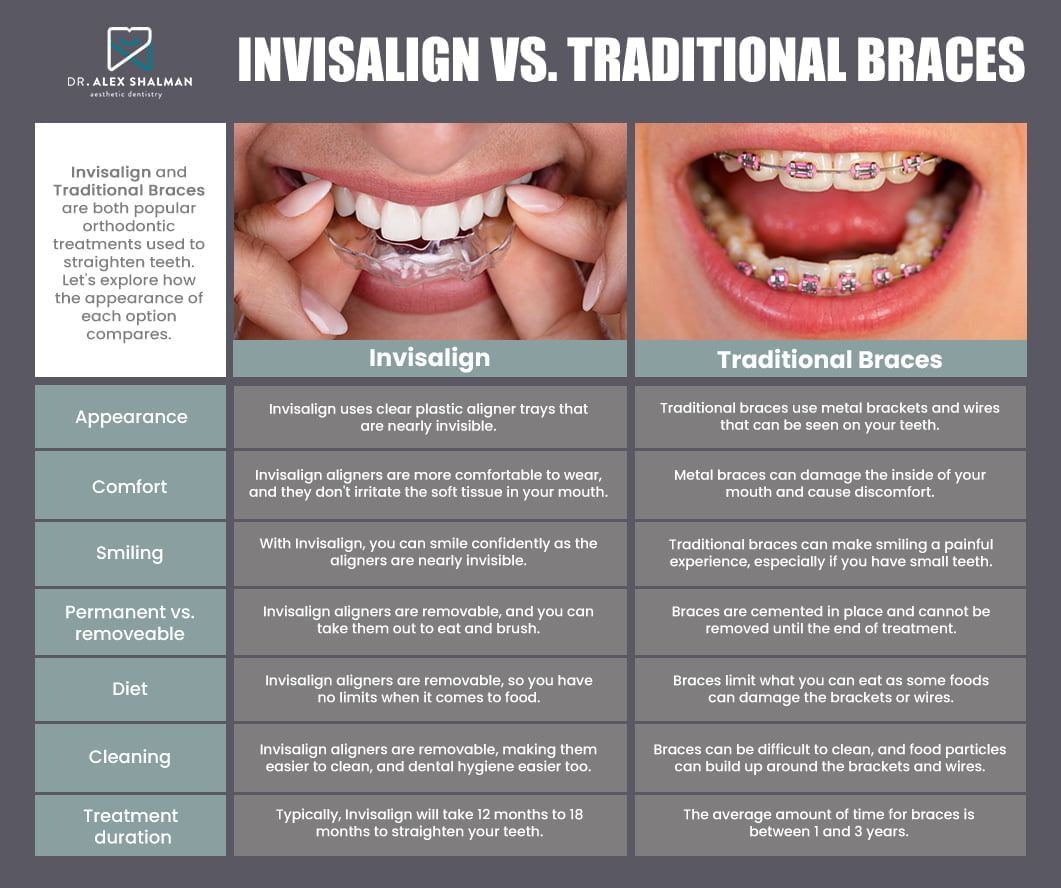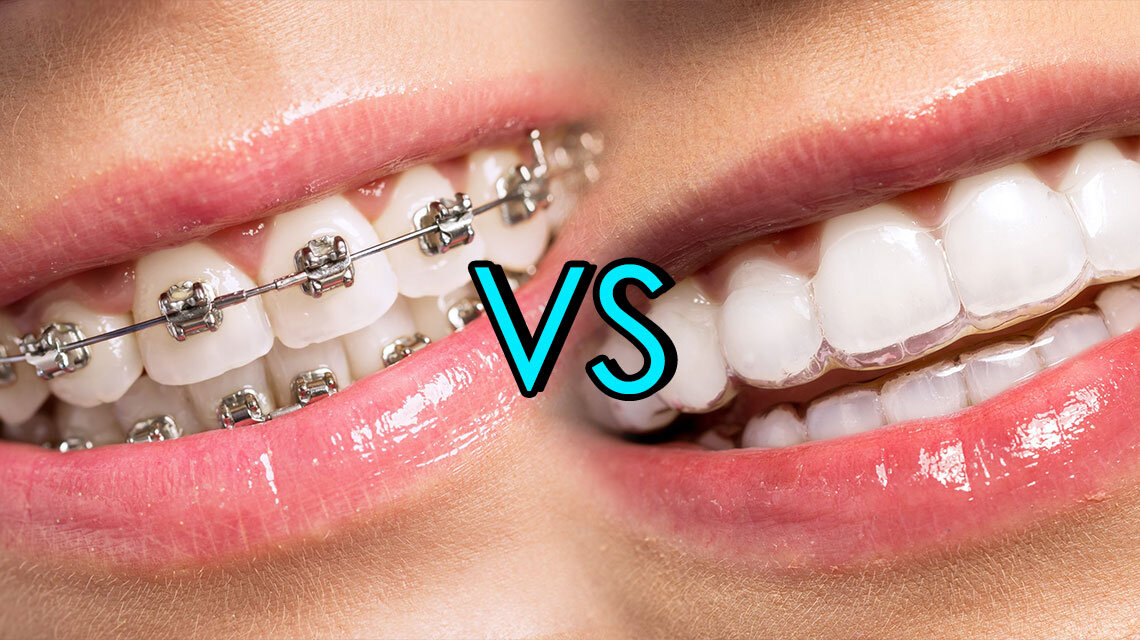The Price of Invisalign: Recognizing the Investment in Your Smile
The Price of Invisalign: Recognizing the Investment in Your Smile
Blog Article
Invisalign vs. Traditional Braces: Which Choice Is Right for You?
When considering orthodontic therapy, the selection in between Invisalign and conventional dental braces presents a number of vital aspects that warrant cautious assessment. Invisalign supplies a discreet option with removable aligners, while typical dental braces offer an extra visible yet reliable service for extreme misalignment. Each option includes distinctive advantages and downsides related to aesthetic appeals, convenience, treatment duration, and expense. Recognizing these subtleties is crucial for making an informed choice that straightens with your individual choices and way of life. The inquiry continues to be: which alternative will finest satisfy your orthodontic requirements and assumptions?
Overview of Therapy Choices

On the other hand, traditional braces are composed of metal braces and wires that are bound to the teeth. This approach applies constant stress over time to accomplish placement. While effective for intricate orthodontic issues, standard dental braces need regular visits for changes and can pose difficulties in maintaining oral hygiene because of the trouble of cleaning around cables and brackets.
Both alternatives have their merits, and the option commonly pivots on particular dental problems, way of life choices, and person compliance. Ultimately, consulting an orthodontic expert is vital for figuring out one of the most ideal therapy plan tailored to private demands. Recognizing the subtleties of each option can substantially affect the overall success of orthodontic treatment.
Aesthetic Considerations
A considerable factor affecting the option between Invisalign and typical dental braces is the aesthetic charm each treatment supplies. Invisalign aligners are crafted from clear plastic, making them essentially unnoticeable when worn.
In comparison, standard braces include metal braces and cables, which can be more obvious. While developments in orthodontic modern technology have actually led to the growth of smaller braces and colored elastics, standard dental braces still maintain an even more conspicuous account. For some individuals, the exposure of dental braces may deter them from looking for needed therapy.
Eventually, the option between Invisalign and typical braces may rest on personal preferences regarding aesthetic appeals. People who focus on discernment typically lean towards Invisalign, while those that are less worried concerning visibility may choose traditional braces. Comprehending the visual implications of each choice is critical for making a notified choice that straightens with one's lifestyle and preferences.
Convenience and Convenience

In regards to ease, Invisalign aligners are detachable, enabling clients to enjoy their favorite foods without restriction and maintain optimum dental hygiene. Cleaning and flossing are simplified, as the aligners can be gotten during these regimens, whereas typical dental braces call for mindful steering around cords and braces.
In addition, Invisalign's dynamic system permits fewer orthodontic check outs. Patients generally obtain numerous collections of aligners at as soon as, which can enhance the therapy process and minimize time invested in the orthodontist's chair. In comparison, traditional braces necessitate routine adjustments, making them much less hassle-free for those with hectic schedules. Invisalign. On the whole, the comfort and ease of Invisalign make it an enticing choice for several individuals looking for orthodontic click for source treatment.
Therapy Period and Efficiency
While both Invisalign and conventional dental braces are effective in dealing with dental misalignments, the period of therapy can vary substantially in between both choices. Normally, Invisalign therapy can take anywhere from 12 to 18 months, depending on the complexity of the situation. The clear aligners function by progressively changing teeth right into their desired settings, and regular follow-ups with an orthodontist assistance guarantee development stays on the right track.
On the other hand, traditional dental braces often call for a longer commitment, typically ranging from 18 months to 3 years. This is due to their fixed nature and making use of cables and braces, which can be extra reliable for severe misalignments and complex cases (Invisalign). The therapy effectiveness of conventional braces is well-documented, as they permit accurate modifications and higher control over tooth motion
Inevitably, the selection in between Invisalign and standard braces may rest on both the anticipated therapy period and the certain oral problems at hand. Consulting with an orthodontist is vital, as they can supply tailored recommendations based on specific demands, making certain the picked technique aligns with desired timeframes and end results.
Price Contrast and Insurance Coverage Choices
Cost plays a substantial duty in the decision-making process for people taking into consideration orthodontic treatment, whether selecting Invisalign or typical dental braces. Usually, the price of Invisalign arrays from $3,000 to $8,000, while conventional braces generally set you back in between $2,000 and $6,000. Elements influencing these prices include the complexity of the situation, the duration of therapy, and geographical area.
Insurance coverage can considerably impact out-of-pocket costs. Lots of dental insurance strategies supply partial protection for orthodontic treatments, yet the specifics can differ commonly. It is critical for clients to review their insurance coverage to determine the level of protection for either option. Usually, standard dental braces may be more frequently covered by insurance policy plans compared to Invisalign, which some insurers categorize as a cosmetic treatment.
Additionally, numerous orthodontic methods check out here use adaptable payment plans, making both treatment choices a lot more easily accessible. People should ask about prospective funding alternatives and price cuts for upfront repayments. Evaluating the total cost, including insurance policy advantages and layaway plan, is crucial for making a notified choice that straightens with both aesthetic preferences and budget considerations.

Conclusion
In summary, the choice between Recommended Reading Invisalign and traditional braces depends upon multiple factors, including aesthetic preferences, convenience, therapy period, and expense. Invisalign uses a discreet, removable option that facilitates oral hygiene and nutritional adaptability, while traditional braces may be more ideal for complicated dental issues and frequently come with a reduced price factor. Ultimately, examination with an orthodontist is vital to assess specific scenarios and figure out the most proper treatment choice for achieving optimal dental positioning.
When taking into consideration orthodontic treatment, the choice in between Invisalign and conventional braces presents a number of important aspects that warrant mindful analysis.Contrasting Invisalign and typical braces reveals distinctive therapy options for orthodontic adjustment.While both Invisalign and conventional dental braces are efficient in dealing with dental imbalances, the duration of therapy can vary significantly between the two choices.Price plays a substantial function in the decision-making process for individuals taking into consideration orthodontic treatment, whether opting for Invisalign or typical braces.In recap, the choice between Invisalign and traditional dental braces pivots on multiple variables, including visual preferences, convenience, therapy period, and cost.
Report this page